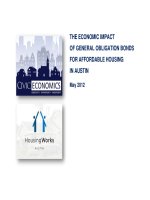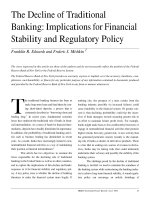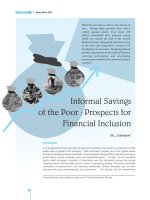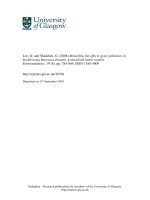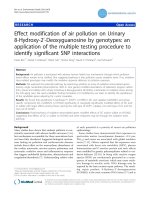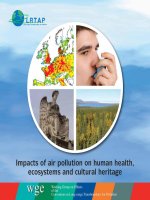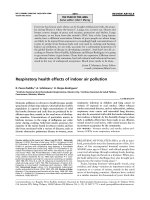Addressing the Impact of Household Energy and Indoor Air Pollution on the Health of the Poor: Implications for Policy Action and Intervention Measures pot
Bạn đang xem bản rút gọn của tài liệu. Xem và tải ngay bản đầy đủ của tài liệu tại đây (587.84 KB, 52 trang )
WHO/HDE/HID/02.9
Original: English
Distr.: Limited
Addressing the Impact of Household
Energy and Indoor
Air Pollution on the Health of the Poor:
Implications for Policy Action
and Intervention Measures
Paper Prepared for
the Commission
on Macroeconomics and Health
Y. von Schirnding, N. Bruce,
K. Smith, G. Ballard-Tremeer
M. Ezzati, K. Lvovsky
World Health Organization
Copyright © World Health Organization 2002
This document is not issued to the general public, and all rights are reserved by the World Health
Organization (WHO). The document may not be reviewed, abstracted, quoted, reproduced or translated, in
part or in whole, without the prior written permission of WHO. No part of this document may be stored in a
retrieval system or transmitted in any form or by any means - electronic, mechanical or other - without the
prior written permission of WHO.
The views expressed in this document by named authors are solely the responsibility of those authors.
Addressing the Impact of Household
Energy and Indoor
Air Pollution on the Health of the Poor:
Implications for Policy Action
and Intervention Measures
Paper Prepared for
the Commission
on Macroeconomics and Health*
(Working group 5 : Improving Health Outcomes of the Poor)
Y. von Schirnding, WHO, Geneva,
N. Bruce, University of Liverpool, United Kingdom
K. Smith, University of California, Berkeley, USA
G. Ballard-Tremeer, Eco Ltd, United Kingdom
M. Ezzati, WHO
K. Lvovsky, World Bank
* Based in parts on the proceedings of a WHO-USAID Global Consultation
on the Health Impact of Indoor Air Pollution and Household Energy in Developing Countries,
Washington DC, 3-4 May 2000.
World Health Organization
Addressing the Impact of Household Energy and Indoor Air Pollution on the Health of the Poor
Implications for Policy Action and Intervention Measures
Table of Contents
Preface
1
2
| Introduction
of the evidence
| ReviewHealth Outcomesfor health effects
2.1 Key
page: 5
page: 7
page: 9
2.2 Other Health Outcomes
2.3 Summary of Evidence
2.4 Shortcomings in Studies
3
global
from
| TheMethods burden of diseaseBurdenindoor air pollution
3.1
for Estimating the
of Disease
page: 17
3.2 Estimates of Global Mortality and DALYs Lost
3.3 Relationship between Development and Burden of Disease from IAP
3.4 Summary
4
intervention
| Policy andthe poor measures that could improve
health of
page: 21
4.1 Interventions
4.2 Other Impacts on Health and Quality of Life
5
issues and
to implementation
| KeyEnergy SectorconstraintsFinancial Support Measures
5.1
Policies and
page: 25
5.2 Intersectoral Action
5.3 Institutional Framework for Technological Solutions
5.4 Variations in National Capacity and Will
6
| Costs
6.1 Comparative Cost - Benefits of Reducing IAP
page: 29
6.2 Cost per DALY Saved
6.3 Scaling up and Sustaining Interventions
6.4 Estimates of Costs
7
| Conclusions
page: 33
Bibliography
Annex A - Range of levels of small particles (PM10 ) and carbon monoxide
found in studies of indoor air pollution in developing countries,
and WHO and USEPA air quality guidelines for comparison
page: 41
Annex B - Biomass fuel use and acute lower respiratory infections
in children under 5 in developing countries
page: 41
Annex C - Examples of the costs and potential reductions in indoor air pollution
levels
page: 45
Annex D - Cost-benefit studies
page: 47
|
3
Addressing the Impact of Household Energy and Indoor Air Pollution on the Health of the Poor
Implications for Policy Action and Intervention Measures
Preface
More than two billion of the world’s poorest people still rely on biomass (wood, charcoal,
animal dung, crop wastes) and coal-burning for household energy needs. Use of these fuels
indoors leads to levels of indoor air pollution many times higher than international ambient
air quality standards allow for, exposing poor women and children on a daily basis to a major
public health hazard. This exposure increases the risk of important diseases including
pneumonia, chronic respiratory disease and lung cancer (coal only), and is estimated to
account for a substantial proportion of the global burden of disease in developing countries.
Evidence is also emerging that exposure may increase the risk of a number of other
important conditions, including TB, low birth weight, and cataract. Other important direct
health impacts from household energy use among the poor include burns to children and
injuries to women from carrying wood. Furthermore, a range of inter-related quality of life,
economic and environmental consequences of household energy use impact on health
through such factors as the time women spend collecting scarce fuel, and restrictions on
educational and economic activity. A wide range of interventions can reduce the impact of
indoor air pollution. These include changes to the source (improved stoves, cleaner fuels),
living environment (better ventilation) and user behaviour (keeping children away from
smoke during peak cooking times). These can be delivered through policies operating at
national level (supply and distribution of improved stoves/cleaner fuels) and local level
(through community development). Experience to date shows that successful implementation
requires participation by local people (particularly women), collaboration between ‘sectors’
with responsibility for health, energy, environment, housing, planning etc., and with an
emphasis on market sustainability. Initial studies suggest that indoor air pollution
interventions perform favourably in terms of cost-effectiveness, with, for example, an
improved stove programme costing US$ 50-100 per DALY saved. Although additional evidence
on health risk is required, concerted global action is needed now to implement cost-effective
interventions which can deliver substantial health benefits to the poor, and contribute to
sustainable development.
|5
Addressing the Impact of Household Energy and Indoor Air Pollution on the Health of the Poor
Implications for Policy Action and Intervention Measures
1
| Introduction
Exposure to indoor air pollution from the combustion of traditional biomass fuels
(wood, charcoal, animal dung, and crop wastes) and coal is a significant public health
hazard predominantly affecting poor rural and urban communities in developing
countries. Large numbers of people are exposed on a daily basis to harmful emissions
and other health risks from biomass and coal-burning, which typically takes place
in open fires or low-efficiency stoves with inadequate venting. It is estimated that
globally 2.5 to 3 billion people rely on these (solid) fuels for everyday household energy
needs (1). The majority of those exposed are women, who are normally responsible for
food preparation and cooking, and infants/young children who are usually with their
mothers near the cooking area.
Although the fraction of global energy from biofuels has fallen from 50 per cent in
1900 to around 13 per cent currently, this trend has levelled off and there is evidence
that biofuel use is increasing among the poor in some parts of the world (1, 2). It is
estimated that daily fuelwood consumption in Africa, for example, is approximately
500,000 tonnes per day. The efficiency of the three-stone open fire used in many
developing countries is only about 10-15% however, thus most of the energy content of
the fuel is wasted (3, 4).
While the majority of people at risk of exposure live in rural areas of the world’s
poorest countries, this is increasingly becoming a problem of poor urban dwellers, a
trend likely to increase with the urban transition. It should be noted too that the
impacts on health of domestic fuel use go beyond indoor air pollution and affect the
household economy, women’s time and activities, gender roles and relations, safety
and hygiene, as well as the local and global environment. For example, it is estimated
that half of the worldwide wood harvest is used as fuel. Further, in some settings, poor
families expend more than 20% of disposable household income to purchase
biofuels, or devote more than 25% of total household labour to wood collection (5).
Biomass smoke contains a large number of pollutants that, at varying concentration
levels, pose substantial risks to human health. Among hundreds of harmful pollutants
and irritant gases, some of the most important include particulate matter, carbon
monoxide, nitrogen dioxide, sulphur dioxide (mainly from coal), formaldehyde, and
carcinogens such as benzo[a]pyrene and benzene. Studies from Asia, Africa and the
Americas (see recent reviews 6, 7 , 8, 9) have shown that indoor air pollution levels
from combustion of biofuels are extremely high – often many times the standards in
industrialized countries such as those set by the U.S. Environmental Protection
Agency (US-EPA) for ambient levels of these pollutants (10).
Whereas cities in industrialised countries infrequently exceed the US-EPA 24-hour
standard for PM10 (small particles of diameter less than 10 microns) in rural homes
|7
Addressing the Impact of Household Energy and Indoor Air Pollution on the Health of the Poor
Implications for Policy Action and Intervention Measures
in developing countries, the standard may be exceeded on a regular basis by a factor of
10, 20, and sometimes up to 50, exceeding even the high levels found outdoors in such
cities as in coal-burning northern China (11). Typical 24-hour mean levels of PM10 in
homes using biofuels may range from 300 to 3,000+ mg/m3 depending on the type
of fuel, stove, and housing – Annex A (9, 12). Concentration levels measured depend
on where and when monitoring takes place, given that significant temporal and
spatial variations (within a house, including from room to room), may occur (8, 9, 13).
Ezzati et al. (8) for example have recorded concentrations of 50,000 ug/m3 or more in
the immediate vicinity of the fire, with concentration levels falling significantly with
increasing distance from the fire. These small particles are able to penetrate deep into
the lungs and appear to have the greatest potential to damage health (14). Levels of
carbon monoxide and other health-damaging pollutants also often exceed
international guidelines (see Annex A).
8
|
Addressing the Impact of Household Energy and Indoor Air Pollution on the Health of the Poor
Implications for Policy Action and Intervention Measures
2
| Review of the evidence for health effects
There is consistent evidence that exposure to biomass smoke increases the risk of a range of
common and serious diseases of both children and adults. Chief amongst these are acute
lower respiratory infections (ALRI) in childhood, particularly pneumonia (6, 15, 16).
Association of exposure with chronic bronchitis [assessed by symptoms] and chronic
obstructive pulmonary disease [COPD - progressive and incompletely reversible airways
obstruction] (assessed by spirometry and clinical assessment) is also quite well established,
particularly among women (7). In addition there is evidence (mainly from China), that
exposure to coal smoke in the home markedly increases the risk of lung cancer, particularly
in women (17, 19).
In recent years, new evidence has emerged which suggests that indoor air pollution (IAP) in
developing countries may also increase the risk of other important child and adult health
problems, although this evidence is more tentative, being based on fewer studies. It includes
conditions such as low birthweight, perinatal mortality (still births and deaths in the first
week of life) asthma and middle ear infection for children, tuberculosis, nasopharyngeal and
laryngeal cancer, and cataract in adults (7).
A summary of the evidence for each of these conditions is given in the section below, based
on recent reviews by Smith et al (6) and Bruce et al (7). The main emphasis is given here to
acute (lower) respiratory infections (ALRI), COPD, and lung cancer (due to coal) for which
the evidence is most robust. The high incidence and mortality of childhood ALRI, together
with the fact that it predominantly affects young children, means that this condition makes
up by far the greatest proportion of the burden of disease attributable to indoor air pollution.
2.1 Key Health Outcomes
• Childhood Acute Lower Respiratory Infections (ALRI)
Acute lower respiratory infections (ALRI) remain the single most important cause of death
globally in children under 5 years, and account for at least 2 million deaths annually in this
age group. There are now sixteen published studies from developing countries which have
reported on the association between indoor air pollution exposure and ALRI, and two further
studies among Navajo Indians in the US (see Annex B). Discussion is restricted here to
studies that have used definitions of ALRI which conform reasonably closely to current
WHO criteria (or other definitions that were accepted at the time the study was carried out)
and/or include radiographic evidence.
These ALRI studies include 10 case-control designs (two mortality studies), 5 cohort studies
(all morbidity), and one case-fatality study. In contrast to the relatively robust definitions of
ALRI, the measurement of exposure in the majority of these studies has relied on proxies,
including the type of fuel used, stove type, exposure of the child to smoke during peak
cooking times, reported hours spent near the stove, and whether the child is carried on the
|9
Addressing the Impact of Household Energy and Indoor Air Pollution on the Health of the Poor
Implications for Policy Action and Intervention Measures
mother's back during cooking. One study made direct measurements of pollution (particulates) and exposure (COHb) in a subsample (20). In that study, respirable particulates in the
kitchens of cases were substantially higher than for controls (1998 mg/m3 vs. 546 mg/m3;
p<0.01), but there was no significant difference in COHb levels. In a recent cohort study in
Central Kenya, individual exposures were estimated by repeated area monitoring and
time-activity budgets coupled with longitudinal monitoring of ARI/ALRI episodes (8, 15, 16).
Five studies reported no significant association between ALRI incidence and exposure (21,
25). In several of these only relatively small proportions of the samples were exposed. Thus,
in urban Brazil only 6% of children were exposed to indoor smoke (22) and in another south
American study 97% of homes used gas for cooking, although 81% used polluting fuels
(kerosene, wood, coal) for heating (25). This study also excluded neonates with birth weight
<2,500 gms – the group most vulnerable to ALRI (25). In the study reported by Shah (23), a
so-called 'smokeless chullah' was used as an indicator of lower exposure, but such stoves
often perform little better than traditional ones in terms of smoke emissions (26).
The remaining studies reported significantly elevated odds ratios (ORs) (for incidence or
deaths) in the range 2-8. Not all studies however, have dealt adequately with confounding
factors (20, 21, 27, 29).
The Navajo studies used case-control designs, reported fuel type (wood vs. cleaner fuel) as a
proxy for exposure and adjusted for confounding (30, 31). Both reported elevated ORs of
approximately 5, although this was not statistically-significant in one study (31). This latter
study also carried out 15 hour PM10 measurements, but found minimal differences between
cases and controls, while the actual levels (median 15 hr PM10 22.4 mg/m3, range 3.2 - 186.5)
were relatively low. However, children living in homes with PM10 > 65 mg/m3 had an OR
of 7.0 (95% CI: 0.9-56.9) times that for children with levels < 65 mg/m3 (31). The recent
study in Central Kenya, which controlled for a number of confounding covariates, obtained
an exposure-response relationship for PM10 exposure and childhood ALRI, with those
in higher exposure categories being 2-3 times as likely as the baseline group classified as
having ALRI (15, 16).
• Chronic Obstructive Pulmonary Disease (COPD)
There are about 20 community – and hospital – based studies with various outcomes that
include chronic bronchitis (by assessment of symptoms) and chronic obstructive pulmonary
disease (COPD – by clinical examination and lung function measurement) (7). Some
patients also go on to develop emphysema [overinflation of the air sacs in the lung] or cor
pulmonale [right heart failure]. The majority of studies found associations between exposure
and COPD, although these are not reported in a consistent manner. As with studies of acute
lower respiratory infections in children, very few carried out exposure assessments, and
confounding was inadequately dealt with in some. Overall, the studies indicate that exposure
to indoor air pollution increases the risk of chronic bronchitis, but, as with ALRI, the relative
risks in some instances may be poorly estimated.
10
|
Addressing the Impact of Household Energy and Indoor Air Pollution on the Health of the Poor
Implications for Policy Action and Intervention Measures
• Lung Cancer
Smoke from both coal and biomass contains substantial amounts of carcinogens, including
benzo[a]pyrene, 1,2 butadiene and benzene. A consistent body of evidence, particularly from
China, has shown that women exposed to smoke from coal fires in the home have an
elevated risk of lung cancer (17, 19), in the range 2-6. This effect has not been demonstrated
among populations using biomass, but the presence of carcinogens in the smoke suggests
that the risk may be present. Synergistic health impact between use of coal for domestic heating and passive smoking from environmental tobacco smoke has also been noted (32).
2.2 Other Health Outcomes
• Upper Respiratory Infection, and Otitis Media
Several studies have reported an association between biofuel smoke exposure and general
acute respiratory illness in children, mostly upper respiratory illness (URI). The Kenyan
cohort study included total ARI as well as ALRI as outcome measures, finding an association
for both (15, 16).
Evidence from developing countries regarding middle ear infection (otitis media) a condition which causes a considerable amount of morbidity - is limited as in general studies
have not differentiated otitis media from all URI, but there is reason to expect an association.
There is now strong evidence that environmental tobacco smoke (ETS) exposure causes
middle ear disease: a recent meta-analysis reported an OR of 1.48 (1.08-2.04) for recurrent
otitis media if either parent smoked, and 1.38 (1.23-1.55) for middle-ear effusion (33). A clinicbased case-control study of children in rural New York State, reported an adjusted OR for
otitis media (two or more separate episodes) of 1.73 (1.03-2.89) for exposure to woodburning
stoves (34). The actual exposure to smoke from wood stoves in industrialized country
situations is much lower than those found in developing country households burning solid
fuels.
• Asthma
Fewer than 10 studies from developing countries examining the association between biomass
fuel smoke and asthma (mainly in children) have been published (7). Again, outcome definitions have not been well standardised, exposure has not been measured and confounding
has not been dealt with in some studies. Evidence so far is inconsistent in both industrialized and developing countries; however, taken together with studies of environmental
tobacco smoke and ambient pollution, the evidence is suggestive that wood smoke pollution
may exacerbate and/or trigger asthma in sensitised people.
| 11
Addressing the Impact of Household Energy and Indoor Air Pollution on the Health of the Poor
Implications for Policy Action and Intervention Measures
• Cancer of the Nasopharynx and Larynx
Several studies have found an increased risk of nasopharyngeal and laryngeal cancer,
although this is not a consistent finding. The most recent study, from South America,
reported an adjusted odds ratio of 2.7 (95% CI: 2.2-3.3), and estimated that exposure to wood
smoke accounted for around one third of such cancers in the region (35).
• Tuberculosis
There have been three published studies to date examining the association with tuberculosis
(two from India, one from Mexico) (7). An analysis of data from 200,000 Indian adults as
part of the Indian National Family Health Survey (1992-93) found that persons living in
households burning biomass reported tuberculosis more frequently compared to persons
using cleaner fuels, with an adjusted odds ratio of 2.58 (95% CI: 1.98-3.37) (36). Although
large, this study relied on self-reported tuberculosis. The other studies used clinically defined
tuberculosis and found consistent results. More research is needed to fully
understand the nature of this relationship. Such an association, if proven, may be due to
reduced resistance to infection as shown in laboratory experiments with animals exposed to
wood smoke.
• Perinatal Mortality
Only one study has been reported from a developing country (37). This found an association
between perinatal mortality (still births and deaths in the first week of life) and exposure to
indoor air pollution, with an odds ratio of 1.5 (95% CI: 1.0-2.1 p=0.05) adjusted for a wide range
of factors, although exposure was not assessed directly. Although this finding is of marginal
statistical significance, there is also some supportive evidence from outdoor air pollution
studies.
• Low Birth Weight
Currently only one study of the effects of fuel use on birth weight in a developing country has
been published (38). This study, conducted in Guatemala, found that birth weight was 63
grams (95% CI: 0.4-127) lower for babies born in households using wood versus those using
cleaner fuels. This estimate was adjusted for confounding but exposure was not assessed
directly. This result is, however, consistent with a meta-analysis of the effects of
environmental tobacco smoke (39) and several outdoor air pollution studies (7, 38).
• Eye Irritation and Cataract
Eye irritation (sore, red eyes and tears) from smoke is widely reported, but there is also
preliminary evidence that it may be associated with blindness. A hospital-based case-control
study in Delhi comparing liquid petroleum gas (LPG) with biomass fuel use found adjusted
odds ratio of 0.62 (95% CI: 0.4-0.98) for cataracts (LPG use had lower risk) (40). Animal
studies report that biomass smoke damages the lens and evidence from environmental
tobacco smoke is also supportive (7).
12
|
Addressing the Impact of Household Energy and Indoor Air Pollution on the Health of the Poor
Implications for Policy Action and Intervention Measures
2.3 Summary of Evidence
Table 1 summarises the nature and extent of the evidence available for health effects of IAP
exposure in developing countries.
Table 1. Health effects of IAP exposure in developing countries
Condition
Nature and extent of evidence
• ALRI (young children)
• Chronic bronchitis and COPD
• Lung Cancer (coal only)
10-20+ studies from developing countries;
fairly consistent across studies, but
confounding not dealt with in a substantial
minority; supported by studies of ambient
air pollution and ETS and to some extent by
animal studies.
• Cancer of nasopharynx and larynx
• Cataract
• TB
Few (2-3) studies from developing countries;
consistent across studies; supported by
evidence from smoking and animal studies.
• Low birth weight
• Perinatal mortality
One study (each) from a developing country,
but supported by evidence from ambient
air pollution and ETS.
• Acute otitis media
• Cardiovascular disease
No studies from developing countries, but an
association may be expected from studies
of ambient air pollution and/or studies of
wood smoke in developed countries.
• Asthma
Several studies from developing countries,
but inconsistent. Some support from
studies of ambient air pollution, but also
inconsistent.
2.4 Shortcomings in Studies
Most existing studies on indoor air pollution and health effects, while providing important
evidence of associations with a range of serious and common health problems, suffer from
a number of methodological limitations, namely (a) the lack of detailed and systematic
pollution exposure determination, (b) the fact that all studies to date have been observational
(no intervention studies) and (c) that some have dealt inadequately with confounding.
Exposure Characterisation
Very few of the studies conducted to date have measured pollutant concentrations or
exposure directly. Indeed characterisation of exposures is one of the most challenging
| 13
Addressing the Impact of Household Energy and Indoor Air Pollution on the Health of the Poor
Implications for Policy Action and Intervention Measures
aspects of work in this field (8, 41). Apart from biomass, a number of other sources of indoor
air pollution may be associated with adverse health outcomes, making it difficult to assess
the independent contributions of various fuel sources to ill-health. It is important to note that
in many countries and settings today, a mixture of fuels is used, including biomass fuel,
liquefied petroleum gas (LPG), and kerosene (42, 44).
Concentration levels of pollutants may vary significantly over time and space. For example
large variations in exposure may result in the course of a day, month, season, or year.
Significant variations may also occur from room to room in a house. In urban and other
industrial areas, exposure to other sources of air pollution need to be taken into account,
and in low-income, high density housing areas (formal or informal), indoor air pollution
also contributes to outdoor air pollution. In Soweto, South Africa for example, indoor coalburning has a profound impact on ambient air pollution, exacerbated by adverse meteorological
circumstances (13). As mentioned, few studies have conducted personal monitoring
of exposures; relying instead on proxies such as type of fuel used, regular carriage of
child on mother’s back, cooking indoors versus outdoors (6, 7). A few have assessed
the frequency, duration and magnitude of contact with measured concentrations of
pollutants (7, 15, 16).
Study design and confounding
The observational nature of the studies presents a particular problem in terms of confounding.
Some studies do not control adequately for confounding factors such as malnutrition,
low birth weight, housing type, or other features of the child’s environment which are
closely associated with poverty. Intervention studies may ultimately result in more
robust evidence on the nature of the relationship between indoor air pollution and
health, nevertheless they may also cause a variety of altered states and behaviours, which
may not be directly related to the impact of indoor air pollution on health. With improved
and more efficient stoves for example, people may cook food for longer periods of time,
thus exposure levels may not be reduced to the extent expected. Or, changes in cooking
practices may result in altered nutrition patterns, also likely to impact on ARI. Impacts
on ARI may be mediated also by changes in birth weight, itself a well documented risk
factor, independent of air pollution (43).
Despite these limitations of epidemiological studies, the evidence on ALRI and chronic
bronchitis (for biomass) and lung cancer (for coal) is consistent, especially when viewed
in conjunction with what is known about the effects of environmental tobacco smoke and
urban outdoor air pollution (notwithstanding their differing pollutant mixtures), and the
evidence from animal studies. The major weakness is the uncertainty about the exact
nature of the exposure-response relationship, that results from the lack of direct exposure
measurement and inadequate control of confounding factors in some studies. For the
other conditions described the evidence must be seen as more tentative, but plausible
given the overall body of research on the effects of air pollution on human and animal
health.
14
|
Addressing the Impact of Household Energy and Indoor Air Pollution on the Health of the Poor
Implications for Policy Action and Intervention Measures
Strengthening evidence, monitoring and evaluation
New studies are needed to help strengthen evidence on health effects, with emphasis on
quantifying the patterns of exposure and risk estimates, and extending knowledge on
potentially important health effects (e.g. TB, low birth-weight and cataract) for which very few
studies currently exist. A variety of studies using different designs need to be conducted in a
range of settings throughout the world. Different populations with varying socio-economic
characteristics and fuel-use patterns should be included. The role of potential confounding
and interactive factors such as nutrition status, breast-feeding practices, level of crowding in
homes, chilling, low birth-weight, environmental tobacco smoke, and other factors need to
be carefully assessed in these studies. Additional well conducted case-control studies, as well
as cohort studies and intervention studies, including randomised controlled trials, are
needed (43).
Also required is strengthening of the tools needed for monitoring and evaluation, including
exposure assessment, indicators and systems for data collection at national level and for poor
rural and urban communities where the need for information and action is greatest.
| 15
Addressing the Impact of Household Energy and Indoor Air Pollution on the Health of the Poor
Implications for Policy Action and Intervention Measures
3
| The global burden of disease from indoor air pollution
The foregoing review provides information on the risk to individuals - the relative risk associated with exposure to IAP from biomass fuels, and coal. It has been emphasised that
very large numbers of people, mainly women and young children, are exposed to this
pollution in a wide range of rural and urban settings, and that the overall public health
impact could be substantial. While acknowledging the uncertainty that exists in estimates of
relative risk, levels of personal exposure, numbers of people exposed and disease rates, it is
nevertheless possible to combine this existing information to quantify the ‘public health
burden’. This approach is encapsulated in the global burden of disease methodology, the
application of which to IAP has been described for India (45) and globally (46). A summary
of the results of the assessment is presented here, based on a recent paper by Smith and
Mehta (46).
3.1 Methods for Estimating the Burden of Disease
Four basic methods for estimating the burden of disease from the use of solid fuels in
developing countries have been described by Smith and Mehta (46). Each has advantages
and disadvantages, but given that their results are fairly similar, taken together they provide
credibility for the approaches taken. Summarised here are results from what has been
termed the fuel-based method (drawing on studies of risk associated with use of different
fuels/stoves and/or reported exposure to them), which tends towards underestimation of
burden compared with other approaches. This method involves applying the results of
epidemiological studies referred to earlier, done solely in developing country households
using solid fuel to estimate the impact by disease and age group (6, 7). Using this method,
conservative assumptions of relative risks for the diseases included are applied to data on the
number of people exposed and the disease rates, to calculate the population attributable
fraction, by region. In practice, adequate estimates of relative risk are only available for
women and children under 5 years. Known relationships between mortality and morbidity
for specific diseases in each age group are then used to calculate years of life lost and
disability-adjusted life years (DALYs) lost.
3.2 Estimates of Global Mortality and DALYs Lost
Table 2 shows the deaths, illness incidence and DALYs lost calculated using the fuel-based
method.
| 17
Addressing the Impact of Household Energy and Indoor Air Pollution on the Health of the Poor
Implications for Policy Action and Intervention Measures
Table 2. Annual burden of disease attributable to solid fuel use, early 1990s
Region
India
China
Other Asia & Pacific Islands
Sub-Saharan Africa
Latin America
Mid-East and North Africa
LDC Total
Deaths
Illness Incidence
DALYs
496,059
516,475
210,721
429,027
29,020
165,761
1,800,000
448,351,369
209,727,474
306,356,582
350,703,204
58,246,497
64,150,732
1,400,000,000
15,954,430
9,335,387
6,599,471
14,323,188
918,236
5,633,022
53,000,000
Excess significant figures retained to reduce rounding errors
Based on Smith and Mehta(46)
The total DALYs (53 million) amounts to slightly more than 4% of the global total for the
countries listed. Table 3 shows the total burden of disease from solid fuel use as a proportion
of the total burden of disease experienced in each region. Compared to China, a larger
percentage of India's DALYs compared to deaths can be attributable to solid fuel use because
young children account for a larger proportion of the deaths in India, while women in China
experience a larger burden of COPD and lung cancer, which occur at older ages. Table 3 also
shows the percentage in each category due to ARI, which correspondingly forms a much
smaller fraction of the burden due to solid fuels in China than in the rest of developing
countries.
Table 3. Percentage of total LDC burden attributable to solid fuel use
Region
India
China
Other Asia & Pacific Islands
Sub-Saharan Africa
Latin America
Mid-East and North Africa
LDC Total
Based on Smith and Mehta(46)
18
|
Deaths
Percent ARI
DALYs
Percent ARI
5.3%
5.8%
3.8%
5.2%
1.0%
3.6%
4.7%
81
25
75
85
71
89
67
5.5%
4.5%
3.7%
4.9%
0.9%
3.7%
4.3%
87
50
85
90
82
93
81
Addressing the Impact of Household Energy and Indoor Air Pollution on the Health of the Poor
Implications for Policy Action and Intervention Measures
3.3 Relationship between Development and Burden of Disease from IAP
Figure 1 shows total burden of disease and burden of disease due to indoor and ambient air
pollution in different regions of the world. Although cross-sectional, these data suggest that
on a global scale, as the income of a region grows the disease burden from IAP falls – and
does so more consistently than the total burden of disease or the burden from outdoor air
pollution. The latter shows a more complex relationship with income, peaking at the interim
stages of development due to the growth of transport and industry with relatively poor
environmental control measures and decreasing again in wealthier countries. High-income
countries have the lowest levels of all three burdens.
6,0%
700,000
Percent of total health risks
500,000
4,0%
400,000
3,0%
300,000
2,0%
DALYs per million people
600,000
5,0%
200,000
1,0%
100,000
0,0%
0
India
Sub-Sarahan
Africa
China
Asia & Pacific Middle-East and
North Africa
Latin
America
Industrialized
countries
Disease burden due to indoor air pollution as % of the total
Disease burden due to urban air pollution as % ot the total
Total disease burden, DALYs per million people
Figure 1: Total disease burden and disease burden arising from indoor and urban air pollution.
Source: World Bank (47)
3.4 Summary
The health consequences of IAP exposure from biomass and other solid fuels in developing
countries should not be ignored for three over-riding reasons. Firstly, the health burden is
high, even though there is uncertainty associated with the exact risk estimates. Secondly, biomass
and coal will continue to be used by a large number of households for the
foreseeable future. The World Energy Council has carried out projections under a variety of
scenarios which indicate that biomass energy use may increase by between 1.1 to 1.3 Gtoe 1 by
2020 (48). Thirdly, the burden of disease due to indoor air pollution is highly concentrated
among the society's most vulnerable groups: women and children in poor rural and urban
households.
1- Gtoe: gigatonnes of oil equivalent – the amount of oil that would have supplied the same amount of energy.
| 19
Addressing the Impact of Household Energy and Indoor Air Pollution on the Health of the Poor
Implications for Policy Action and Intervention Measures
4
intervention
| Policy andthe poor measures that could improve
health of
In considering strategies to reduce disease due to exposure to indoor air pollution, it is
important to distinguish between interventions such as changes in energy technology (fuel,
stoves), behaviour, etc., on the one hand and policy for implementing and sustaining those
changes. These are discussed in the following section.
4.1 Interventions
A wide range of interventions can contribute to reducing exposure to indoor air pollution.
These can be classified under three headings (49): source (fuel, type of stove); living
environment (housing, ventilation); and user behaviour (fuel drying, protection of child) see Table 4.
Table 4. Potential interventions for reducing IAP exposure in developing countries (49)
Source
Improved cooking devices
Living Environment
Improved ventilation
• Chimneyless improved
biomass stoves
• Improved stoves with
flues attached
• Hoods / fireplaces and
chimneys (built into
structure of house)
• Windows /ventilation
holes
Alternative fuel-cooker
combinations
• Briquettes and pellets
• Charcoal, Kerosene
• Liquid petroleum gas
(LPG)
• Biogas, Producer gas
• Solar cookers (thermal)
• Other low smoke fuels
• Electricity
Kitchen design and placement of the stove
• Shelters / cooking huts
• Stove at waist height
User behaviour
Reduced exposure through
operation of source
• Fuel drying
• Use of pot lids
• Good maintenance
• Sound operation
Reductions by avoiding
smoke
• Keeping children out of
smoke
Food preparation
• Partially pre-cooked
food
Reduced need for the fire
• Efficient housing
• Solar water heating
| 21
Addressing the Impact of Household Energy and Indoor Air Pollution on the Health of the Poor
Implications for Policy Action and Intervention Measures
There has to date been little in the way of systematic evaluation of the direct (e.g. reduction
of IAP exposure, safety) and indirect (e.g. opportunity costs of women’s time, environmental
impacts, etc.) effects of these potential interventions on health, and in particular their
distribution within the household (women, men, children for example, may be differentially
impacted by various types of interventions). Most of the information available relates to the
impact on fuel consumption and on direct emission levels. As a result, current knowledge is
almost entirely restricted to source interventions, and mainly for various types of improved
stove.
The initial emphasis from the 1970s on fuel efficiency (aimed at reducing costs and
protecting the local environment) brought with it a somewhat narrow focus on technological
solutions that included primarily improved biomass stoves. These stoves include enclosed
mud devices, often with flues, which on the whole were unsuccessful due to low efficiency
and rapid deterioration. A large-scale stove programme in India appears to be
suffering from these problems, although a thorough evaluation has not been conducted
yet. Further, initial work on the benefits of improved stoves was often marked by a lack
of appropriate data on stove performance in everyday use. Efficiencies and emissions, for
example, were often measured in controlled environments as the stoves were used by
technical experts under conditions very dissimilar to those in the field (50, 51).
Recent surveys have identified several hundred improved stoves programmes (not counting
larger changes in household energy technology such as electrification or biogas) in over 50
countries (52) ranging from entirely local, non-governmental advocacy to national initiatives
reaching millions of households - as has been achieved in rural China (53). The implication
of such a variety of programmes has been that the quality and efficiency of individual stoves
has varied greatly, as has the success of individual programmes. The lack of success with
some of the initial technologies and programmes shifted focus to the factors that can result
in successful technical design and dissemination of improved stoves (54). In programmatic
terms, a more successful approach has been with ceramic chimney-less stoves which are
cheap, relatively durable, and more fuel-efficient. Such stoves have been quite popular,
especially where sustainable markets have developed – for example in Kenya (54, 55). These
stoves can reduce indoor air pollution because of better combustion, with lower emissions
and potentially also shorter cooking times. Development of local production and markets has
also been key to the success of the Chinese rural stove programme (53).
One of the reasons for the lack of systematic studies may have been that, with the central role
of energy technology in household livelihoods, the adoption of interventions are more likely
to vary from setting to setting and even household to household (44). For this reason, a more
appropriate and realistic approach to evaluating the health benefits of interventions would be
to consider the set of possible scenarios that may take place with the introduction of
any intervention, as well as the corresponding health benefits. Recently, the reduction in
emissions and exposure as a result of improved stoves has been considered in Guatemala
and Kenya (8, 56), as well as health benefits using a range of intervention scenarios (57). This
analysis shows that transition from wood to charcoal can reduce exposure to indoor PM10
22
|
Addressing the Impact of Household Energy and Indoor Air Pollution on the Health of the Poor
Implications for Policy Action and Intervention Measures
by more than 80%, although wider environmental impacts of charcoal production must be
considered (58). The corresponding reductions for improved ceramic woodstoves are
between 35% and 50% . The estimated reductions in the incidence of childhood ALRI are
between 21% and 44%.
Despite these recent advances, three key questions in design of programmes for reducing
the health impacts of indoor air pollution from biofuels remain: first, although the benefits
of adopted interventions are known, it is not entirely clear what set of factors would motivate
households to adopt any intervention or suite of interventions. Second, the performance of
interventions in exposure reduction have not been monitored over long time periods. Third,
knowledge is scarce about the wider implications and sustainability of many of the proposed
interventions within certain environmental and socio-economic contexts. For example,
encouraging a shift to charcoal could lead to even more severe environmental degradation
and fuel scarcity, as more wood is needed per meal using charcoal compared to wood
(58, 59).
4.2 Other Impacts on Health and Quality of Life
As mentioned earlier there are a wide range of other factors associated with the supply and
use of household energy in poor countries that can be expected to impact on health. This
includes direct health consequences such as burns to children falling into open fires, as well
as the less direct health impacts associated with a range of other energy-related socioeconomic factors. The total evidence available on the health consequences is of variable
extent and quality, partly due to a paucity of research attention in this field, but also due to
the methodological challenges of demonstrating cause and effect where a range of social,
environmental and other factors interact. This is an important area for further review and
investigation. Some of the key factors which should be considered are summarised below:
| 23
